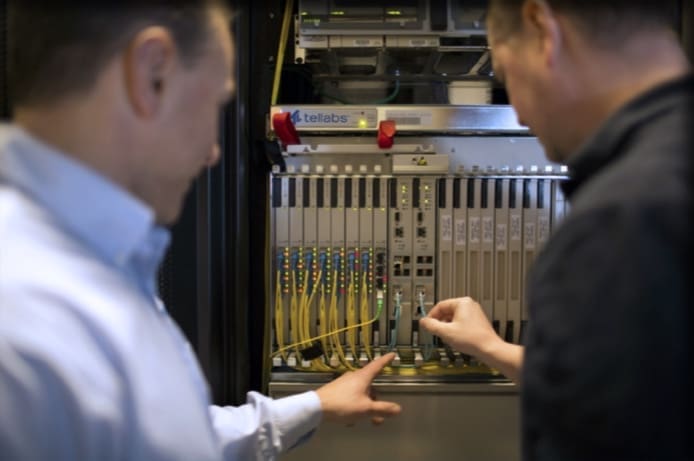Tellabs Provides Solution Platform, Helps Install and Activate Network
Business Challenge
 Deltek, based in suburban Washington, D.C., provides enterprise software and information solutions for project-based businesses around the world. More than 16,000 organizations in over 80 countries use Deltek solutions to help them win new business, optimize resources, streamline operations and deliver more profitable projects.
Deltek, based in suburban Washington, D.C., provides enterprise software and information solutions for project-based businesses around the world. More than 16,000 organizations in over 80 countries use Deltek solutions to help them win new business, optimize resources, streamline operations and deliver more profitable projects.
In late 2011, Deltek consolidated its five facilities in metropolitan Washington, D.C., along with 700 of the company’s 1,700 worldwide employees, into a new headquarters building in Herndon, Virginia.
At its previous locations, Deltek had used a copper-based LAN architecture and was considering deploying the same kind of LAN in the new building as well. In fact, the required communications closets, copper cabling and horizontal infrastructures were already in place.
However, before deciding on a particular LAN solution vendor for the new building, Deltek IT managers wanted to ensure that whatever LAN solution they chose could satisfy a broad range of company requirements. Specifically, they wanted a LAN that could:
- Deliver ultra-reliable performance.
- Reduce hardware and hardware maintenance costs.
- Reduce or eliminate service agreement costs associated legacy active Ethernet architecture.
- Reduce operational support requirements.
- Support Ethernet and thus integrate easily with Deltek’s existing core switch.
- Support Deltek’s VoIP service.
- Deliver up to Gigabit speeds to all employees, compared to the 10 Mbps at old office.
Further, because of the company’s emphasis on environmental sustainability, Deltek wanted to find out if a LAN solution was available that consumes less power than traditional LAN architectures.
Why Tellabs
Deltek had selected NET100, a local structured-cabling firm, to install the cabling infrastructure in the new building. NET100 recommended that Deltek consider deploying an optical network because of its multiple advantages over traditional LAN architectures: less cabling, fewer active electronics for reduced power consumption, less maintenance and a smaller physical footprint — all of which add up to lower CapEx and OpEx costs. Having worked with Tellabs products before, NET100 proposed that Deltek look at the Tellabs Optical LAN solution, based on G-PON technology.
Deltek agreed to consider the Passive Optical LAN and asked Tellabs and NET100 for a detailed presentation of the solution. The presentation emphasized that several U.S. government agencies already rely on the Tellabs solution. Compared with copper-based LANs, the Optical LAN has proven to reduce CapEx by up to 70%, power consumption by up to 80% and the required amount of floor, rack and closet space by up to 90%.
After evaluating the Passive Optical LAN, Deltek realized that the solution not only satisfies each item on the company’s checklist of communications requirements but also delivers more near- and long-term cost savings than traditional LAN solutions.
Tellabs Solution
Deltek, Tellabs and NET100 jointly designed the Deltek network. After converting the new six-story building’s infrastructure to accommodate fiber, rather than copper, NET100 installed the single-mode fiber cabling. The NET100 technicians, who are trained on Tellabs Optical LAN technology, then installed the equipment.
On each floor of the six-story building are two communications closets, which Deltek’s architect had incorporated before Deltek decided to deploy an optical solution instead of an active Ethernet LAN. The NET100 and Tellabs Professional Services team installed passive fiber-distribution hub panels in the closets, leaving a significant amount of empty space in each one along with eliminating the need for power or cooling.
 On the first floor, a three-person team deployed the Tellabs 1150 Optical Line Terminal (OLT) with eight G-PON cards. Fundamental to the OLT, the Tellabs 1150 uses a native Ethernet switching infrastructure with 1G and 10G network-side interfaces terminating on two Ethernet switching units supporting standard IEEE protocols. In addition, the team installed eleven 729F ONTs, each with 24 Ethernet data interface ports and 24 POTS interface ports for carrier-grade voice services.
On the first floor, a three-person team deployed the Tellabs 1150 Optical Line Terminal (OLT) with eight G-PON cards. Fundamental to the OLT, the Tellabs 1150 uses a native Ethernet switching infrastructure with 1G and 10G network-side interfaces terminating on two Ethernet switching units supporting standard IEEE protocols. In addition, the team installed eleven 729F ONTs, each with 24 Ethernet data interface ports and 24 POTS interface ports for carrier-grade voice services.
At pairs of desktops throughout the Deltek facility, the NET100 – Tellabs team installed a total of 700 Tellabs 709G ONTs. Featuring four Gigabit Ethernet data interface ports with Power- over-Ethernet plus (PoE+), the ONTs deliver data, VoIP and video services to Deltek employees.
Business Results
 Today, Deltek employees have Gigabit-to-the-desktop bandwidth, which supports integrated VoIP, data and video service throughout the building. The Tellabs Optical LAN solution provides all users with access to Gigabit speeds, including guaranteed bandwidth for user-critical applications. With fiber’s virtually unlimited bandwidth, the Optical LAN boosts Deltek’s ability to satisfy its future communications requirements.
Today, Deltek employees have Gigabit-to-the-desktop bandwidth, which supports integrated VoIP, data and video service throughout the building. The Tellabs Optical LAN solution provides all users with access to Gigabit speeds, including guaranteed bandwidth for user-critical applications. With fiber’s virtually unlimited bandwidth, the Optical LAN boosts Deltek’s ability to satisfy its future communications requirements.
Tellabs solution, with its support for Ethernet protocols, easily integrated with Deltek’s core switches, thereby enabling the company to protect its existing network investments. Further, because Deltek no longer has to “refresh” or swap out switches every four to seven years, as it had to do with the copper-based LAN architecture in its previous facilities, the Tellabs solution enables the company to achieve even greater CapEx and time savings.
The operational simplicity of the Tellabs Optical LAN means that Deltek IT staff members do not have to spend a lot of time on LAN and port management, so they can focus on other support activities throughout the building. In fact, a two-person IT team easily manages the Tellabs Optical LAN and its 700-plus ONTs throughout the building.

These benefits, combined with the reduced power consumption and physical space requirements, add up to a significant reduction in Deltek’s total cost of ownership for the Tellabs solution.
Because the new building already contained communications closets, Deltek could not achieve the additional space savings that Optical LAN typically allows. However, George Goforth, Deltek vice president of IT, says that the closet space “is turning into great storage. I don’t have to get warehouse space anymore.”
“We plan to use Tellabs Optical LAN going forward in our LAN networks,” he adds, “We recommend that all enterprise organizations consider Tellabs Optical LAN for their next- generation network.”
Tellabs
In today’s competitive market, enterprises and service providers want to cut costs and improve services by doing things more efficiently. Tellabs is responding to their needs with a new approach to network design and service definitions. For example, we purpose-built Tellabs Optical LAN solution to leverage the cost, power and space benefits of an all-fiber infrastructure in providing high-capacity, high-performance networks.
Compared with legacy copper-based Ethernet networks, Passive Optical LAN offers more reliable and secure delivery of data, voice and video services on one platform. In addition, it eliminates future infrastructure upgrades and provides an environmentally sustainable solution.


